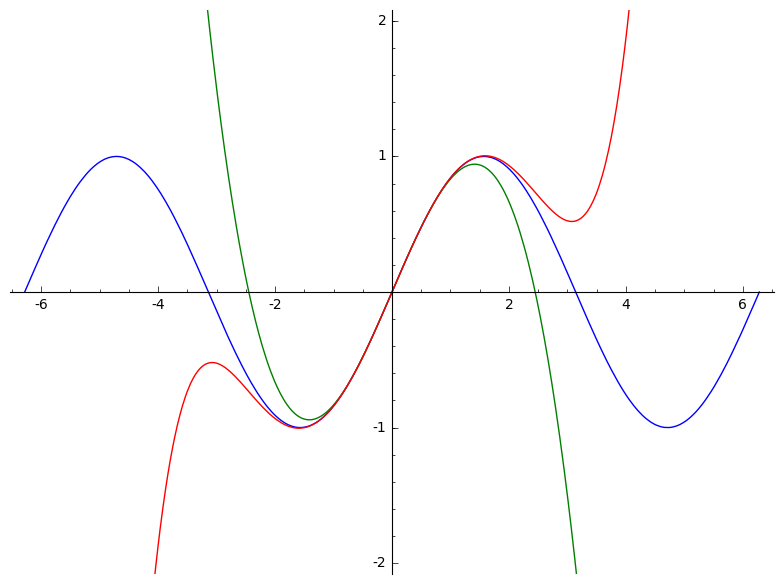H1: Formules van Taylor en Mac-Laurin
Voorbeeld
a) Bepaal van $f(x)=\sin{x}$ de Taylorontwikkelingen $T_3$ en $T_5$ rond $x=0$ (resp. van orde 3 en 5) .
|
File: /opt/sage/sage-7.4/local/lib/python2.7/site-packages/sage/calculus/functional.py Type: <type ‘function’> Definition: taylor(f, *args) Docstring:
File: /opt/sage/sage-7.4/local/lib/python2.7/site-packages/sage/calculus/functional.py Type: <type ‘function’> Definition: taylor(f, *args) Docstring:
|
|
|
b) Teken de grafiek van $f(x)=\sin(x)$ samen met de grafieken van $T_3,T_5$ in het interval $[-2\pi,2\pi]$ (geef elke grafiek een andere kleur)

|
Opgave 1
Bepaal de Mac-Laurin-reeksontwikkeling van de functie $f(x)=e^{\sin(x)}$ t.e.m. termen in $x^4$. Maak gebruik van deze reeksontwikkeling om een benadering te bepalen voor $f(0.1)$. Bereken de afwijking van deze waarde t.o.v. de exacte waarde van $f(0.1)$. (oefening 1.8(b))
|
|
Opgave 2
Bepaal de Taylor-reeksontwikkeling van $f(x)=\ln\left(\frac{3x}{1+x}\right)$ in de omgeving van $x=\frac{1}{2}$ t.e.m. termen in $x^3.$ Gebruik deze reeksontwikkeling om een benadering te bepalen voor $f(0.6)$. Bereken de afwijking van deze waarde t.o.v de exacte waarde van $f(0.6)$. (oefening 1.8(d))
|
|
Opgave 3
a) Bepaal de Mac-Laurinreeksontwikkeling van $f(x)=\sqrt{4+x}$ t.e.m. termen in $x^6$. Teken de grafiek van $f(x)$ samen met de bekomen reeksontwikkeling voor $x \in [-4,8]$.
b) Gebruik $f(x)$ om $\sqrt{5}$ te berekenen op 10 decimalen en gebruik de reeksontwikkeling om een benadering van $\sqrt{5}$ te bepalen op 10 decimalen. Bereken (de fout) het verschil tussen de twee bekomen waarden voor $\sqrt{5}$ . Doe nu hetzelfde voor $\sqrt{10}$ (ook op 10 decimalen).
c) Probeer de benadering op 10 decimalen van $\sqrt{5}$ en van $\sqrt{10}$ te verbeteren door meer termen in de Mac-Laurin-reeks te nemen: eerst tot $x^{10}$, dan tot $x^{15}$ en tenslotte tot $ x^{20}$. Wat valt op als je de fout bekijkt? Kan je dat verklaren?
a)
|
|
b)
|
|
|
|
c)
|
|
|
|